Contents
Market Overview
Macro Review
Fed delivers the most confusing FOMC yet. The statement was initially perceived as hawkish given the U.S. Treasury curve bear flattened and algos bought Eurodollar futures as the word “substantial” was removed from “further progress”, although the press conference was far more dovish. This kept USD under pressure at a one-month low. The tapering landscape seems set to be delayed from Jackson Hole to September/November, before eventually commencing in December/January. Equally, Chair Powell highlighted that an even tapering composition across MBS/Treasuries was necessary, rather than slowing MBS purchases as a number of FOMC members have advocated. Notwithstanding, 2Q GDP missed expectations at 6.5%, falling shy of expectations of 8.4%, while quarterly PCE also tilted higher just as the 1Q revision hit the tape as monthly data for June remained elevated at 2.7%. This comes as Germany posted its highest CPI print since 2008. The IMF global growth forecasts were also unchanged at 6.0% but the composition is skewed to the upside for DM and downside for EM as the U.S. forecast was increased by 60bp in 2021 (7.0%) and 140bp in 2022 (4.9%). However, this development came just as GS downgraded their U.S. growth forecast for 2022 to 4.4%. Needless to say, markets were in risk-on mode as the S&P reached a new all-time high of 4,400 as Guggenheim now calls for 5,000 by year-end. Not only were U.S. markets in a state of flux, but Chinese equities were thrown into disarray by regulation explicitly barring foreign investments in private education companies, which operate under Variable Interest Entities (VIE). This in turn created panic across tech names given most companies in the sector operate via VIE structures. Other regulatory changes impacted music rights (Tencent Music), food delivery services (Meituan) and the property sector. China’s largest property developer (Evergrande) traded down to 38cts on the dollar as contagion spread across the industry, although regionally it appears isolated just as S&P and Fitch downgraded the credit rating to triple C.
EM Credit Update
EM Credit ended the week down 0.1% and 3bp wider in spread but is still up 0.2% on the month through July. The reference to the monthly return is important as EM Sovereign Credit in spread is 17bp wider, which is the worst July move in spread since 2007. However, at the same time this resets some value within the EM asset class as US Treasury volatility declines. Outperformers on the week include Zambia, Lithuania and Belarus, while Tunisia, Ethiopia and Peru lagged.
The Week Ahead
Next week we would expect a pick-up in China’s Caixin PMIs as semiconductor chip production begins to offset slower output in the auto sector. Meanwhile, the impact on trade and notably mobility will remain in focus across Asia from China to Taiwan to Indonesia. Nevertheless, we would expect more scrutiny on regulatory measures given recent volatility that domestic measures in China have triggered. When it comes to interest rate decisions the UK (0.1%) and Australia (0.1%) stand out, but we can expect more from Brazil (4.25%) and Czech Republic (0.5%) as Colombia (1.75%), Czech Republic (0.5%), Egypt (8.25%), India (4.0%) and Thailand (0.5%) are expected to hold rates unchanged. Inflation out of Chile, Colombia, Indonesia, Mexico, Peru, South Korea and Turkey may create a headline, and to a lesser extent GDP out of Mexico.
Highlights from emerging markets discussed below include: The inauguration speech and cabinet appointments of Peru’s new President, Pedro Castillo; China regulatory action in strategic sectors; Tunisia at a major inflection point as constitutional crisis escalates; and emerging market corporates in focus: assessing the implications of slower population growth.
Fixed Income
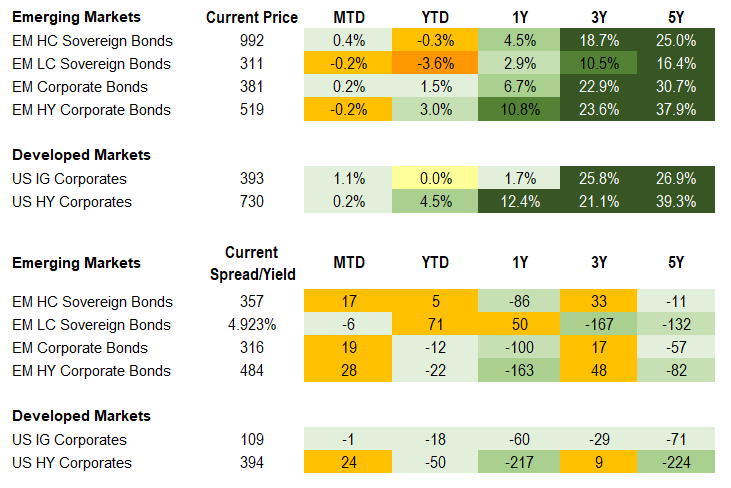
Equities
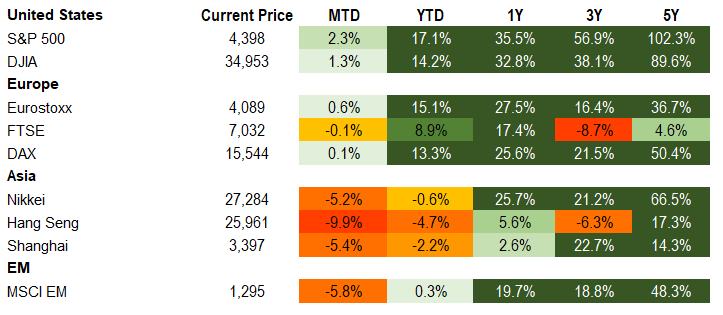
Commodities

Source for data tables: Bloomberg, JPMorgan, Gramercy. EM Fixed Income is represented by the following JPMorgan Indicies: EMBI Global, GBI-EM Global Diversified, CEMBI Broad Diversified and CEMBI Broad High Yield. DM Fixed Income is represented by the JPMorgan JULI Total Return Index and Domestic High Yield Index. Fixed Income, Equity and Commodity data is as of July 30, 2021 (Mid Afternoon).
Emerging Markets Weekly Highlights
The inauguration speech and cabinet appointments of Peru’s new President Pedro Castillo yielded more questions than answers
Event: President Castillo was sworn into office on July 28th following the JNE’s validation of the election results last week. He called for a Constituent Assembly with its purpose to write a new constitution and plans to present a constitutional amendment to Congress for its creation. Fiscal policy intention entails higher spending and larger role of the public sector, particularly in natural resource sectors, as well as prospects for some price and lending regulation. The majority of the cabinet appointments have been made with an unorthodox tilt, most notably with Guido Bellido, close ally of ruling party head and ideologue Vladmir Cerron, as the Prime Minister. The long awaited and market relevant Finance Minister position has yet to be announced at the time of writing.
Gramercy Commentary: We continue to expect uncertainty to persist given Castillo’s lack of political experience, divided Congress, and the administration’s desire for a more interventionist policy approach. The leftist tilt of the cabinet combined with the controversial status of Bellido increase the likelihood that Congress will deny the vote of confidence to the cabinet, already challenging government stability. If Congress fails to approve the cabinet twice, Castillo can dissolve Congress and call for new legislative elections. These immediate governability challenges combined with likely headwinds on the reform for the Constituent Assembly give rise to medium term impeachment risk on moral capacity (requires 87 out of 130 votes; Peru Libre holds 37 seats). While there is still the possibility for a more neutralizing appointment for the Finance Ministry and continuity with central bank leadership, we see growing asymmetric downside risk to prices with most acute pressure in the local market, despite likely continued BCRP intervention.
China regulatory action in strategic sectors will continue to drive volatility
Event: Earlier this week, China’s regulatory bodies and agencies including the SAMR (State Administration for Market Regulation), MIIT (Ministry of Industry and Information), CAC (Cyberspace Administration of China), and MSS (Ministry of State Security) enacted a set of regulations in the technology sector, including specific measures for ride-hailing giant Didi and tech conglomerate Tencent. Additionally, they banned profit or IPOs in the education sector and further tightened measures in the property market.
Gramercy Commentary: The policy action is likely an aim to align the private sector with China’s medium and long-term goals in the technology industry in relation to data security and preference to focus capital in core technologies such as semiconductors and biotechnology. Social issues and the cost of living are likely elements in play for the measures in the education and property sectors. We continue to expect fine-tuning of policy and regulation that aims to support parts of the economy which remain weak. We expect China to use tools such as the reserve requirements ratio balanced with actions to preserve financial stability, pursue improvements to social equality and stability, and prioritize strategic investment. As such, we expect further market volatility and headwinds to growth in 2H21 but still anticipate activity to remain around or just shy of 8% y/y for the year.
Tunisia at a major inflection point as constitutional crisis escalates
Event: On July 25th, the anniversary of Tunisia’s independence from France, populist and nationalist President Kais Saied took advantage of the street protests over economic hardships and the perceived mishandling of the COVID-19 crisis by the government to fire Prime Minister Hichem Mechichi, a political opponent of the President, and to suspend Parliament for 30 days.
Gramercy Commentary: Tunisia’s lingering institutional crisis has taken a dramatic escalatory turn this week, increasing risks of political and social instability and essentially freezing already complicated talks over an IMF program. The country, considered by many the only example of a successful democratic transition following the so-called “Arab Spring” of 2011, appears to be at a major crossroad between preserving its constitutional framework and sliding back into some form of authoritarian government. The Speaker of Parliament, also a political rival of Saied, labeled the President’s actions “a coup”; it is still unclear how the international community, especially Tunisia’s regional and western financial donors, read the events. Most importantly from a market perspective, the escalation of Tunisia’s political crisis, will undoubtedly further slow reform implementation and effectively put a halt on talks with the IMF over a new program agreement that ousted PM Mechichi’s Administration formally requested back in April. Investors see the potential IMF financial backstop as a key anchor of market confidence in the context of Tunisia’s large fiscal and external deficits and rising debt burden. The economy and its labor-intensive tourism sector have been hit hard by the pandemic, which is feeding into social discontent, political volatility and macroeconomic pressures. In the absence of an IMF anchor and financing, central bank reserves will need to cushion near-term external debt service, which could pressure the external buffer in the event of a protracted political crisis and no prospects for revival of IMF discussions. Markets have reacted sharply to the crisis escalation, however, we believe downward pressure on Tunisia’s sovereign bond complex is likely to persist in the near-term, driven by the probable continuation of significant political uncertainty as the constitutional crisis and power struggle unfold.
Global emerging market corporates in focus: Assessing the implications of slower population growth
Event: China’s birth rate is the lowest it has been in almost six decades, leading some to suggest that the population of the world’s second largest economy may peak before 2025. Other jurisdictions have also reported slower population growth in recent periods. This may have implications for emerging market corporates.
Gramercy Commentary: Sustained lackluster population growth may lead to an ageing population. This could impact demand for certain products and services. Specifically, there may be even greater demand for pensions and insurance products, and for healthcare goods and services. This could be seen as positive for financial services providers, companies specializing in the manufacture of healthcare and age related goods and institutions running hospitals and care homes. Lower birth rates may also eventually lead to labor shortages, which may result in higher wage inflation. This could impact companies’ margins and profits. Such trends could also mean that the focus will be on labor productivity increases, possibly resulting in increased automation. This would undoubtedly require incremental capital expenditure by the corporates impacted. Where there are state pensions, slower population growth may increase the pension burden on the government. In some markets, this has resulted in such governments raising the retirement age. This may not be easy to do in some jurisdictions – such changes are known to have resulted in social unrest, which may be disruptive for businesses. Labor shortages resulting from lower birth rates could also lead to increased migration. This may be positive for countries which get a boost to the labor force but may have unintended consequences on the countries from which such individuals migrate – labor shortages may be exported to these countries. Companies may consider offshoring when faced with labor shortages due to slower population growth. This can sometimes lead to lower production costs, but is also not without risks. These risks may include foreign currency volatility, changes in foreign labor market laws and exposure to non-domestic political risks. Government schemes to reverse the impact of slower population growth are also worth considering. Such schemes may include incentives to encourage larger families. This may be a positive for companies producing childcare related goods, which would otherwise have come under strain.
Emerging Markets Technicals
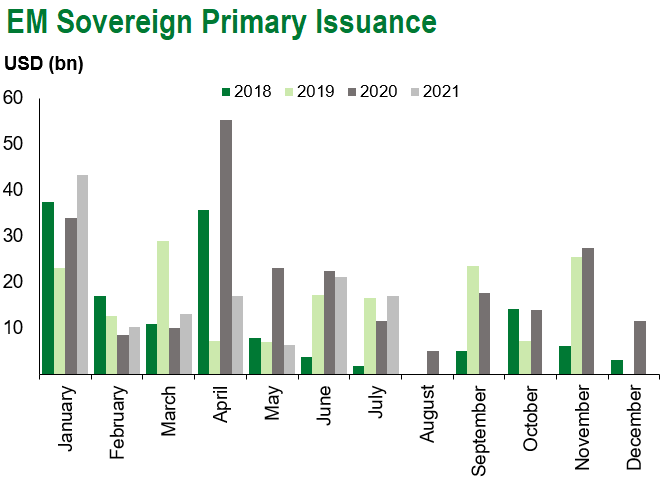
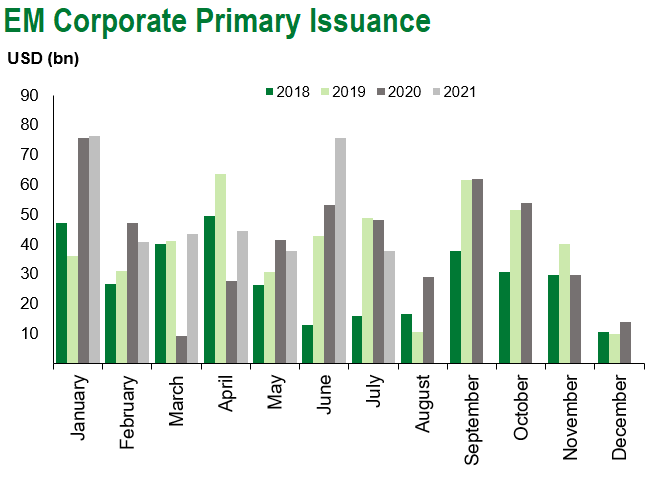
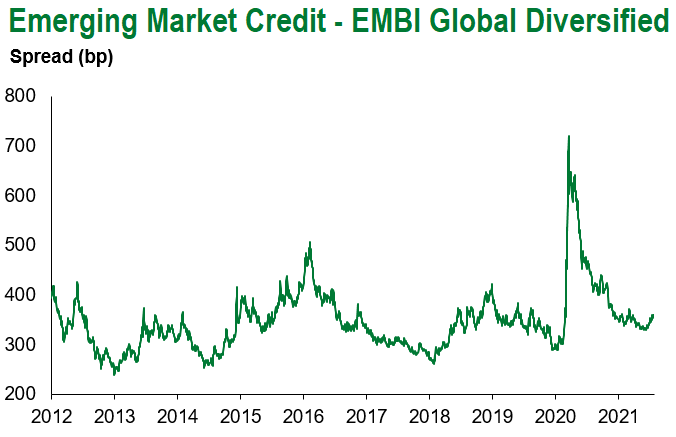
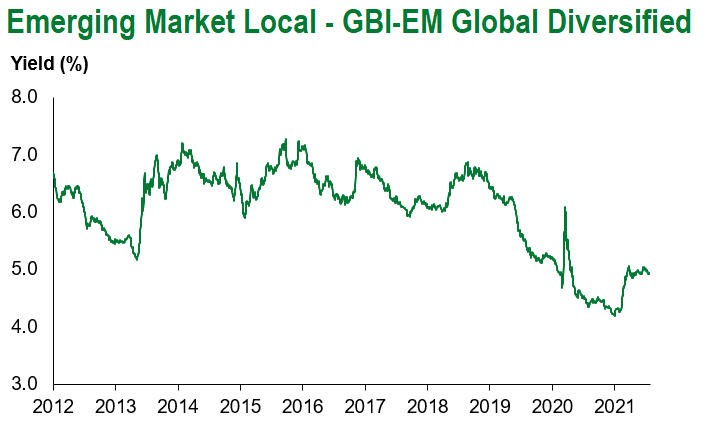
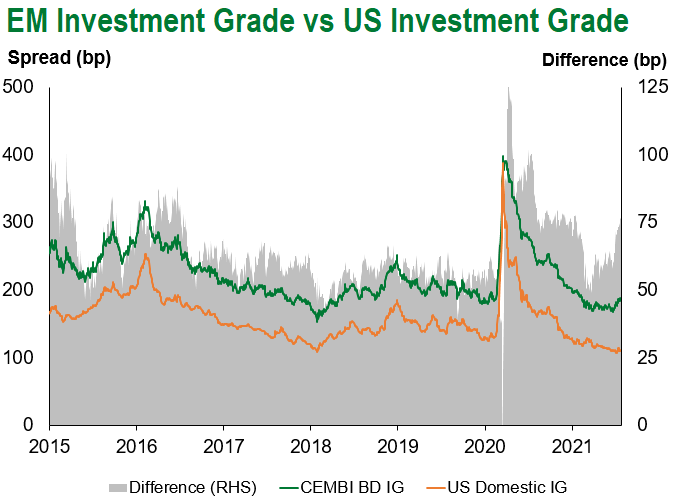
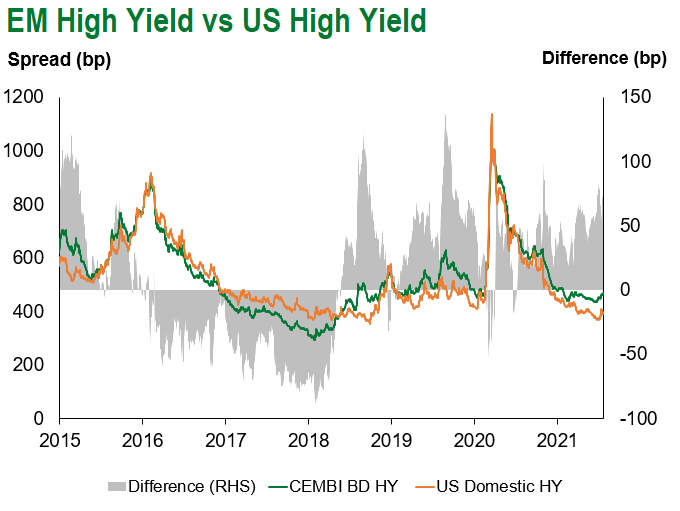
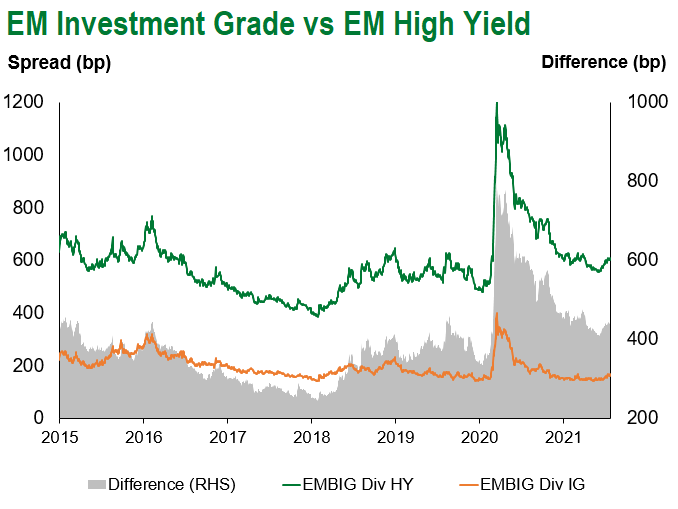
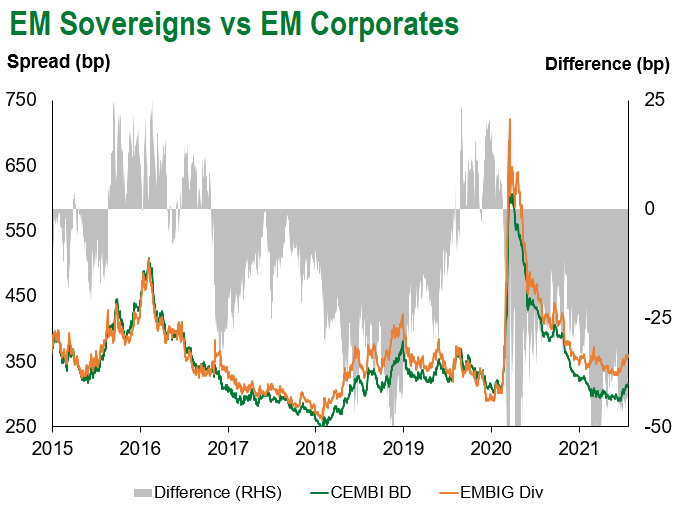
Emerging Markets Flows
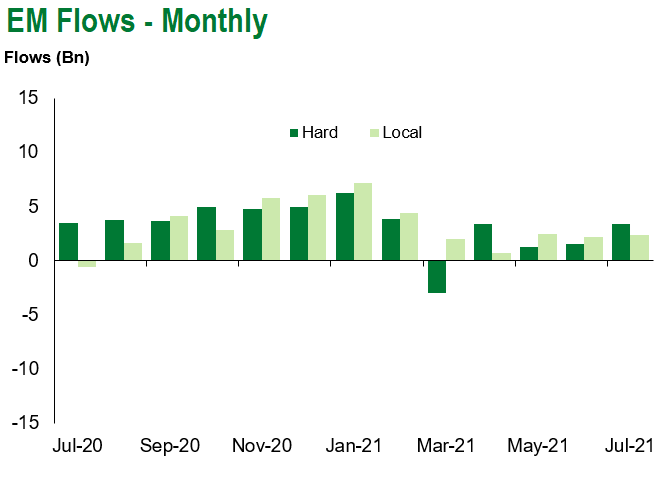
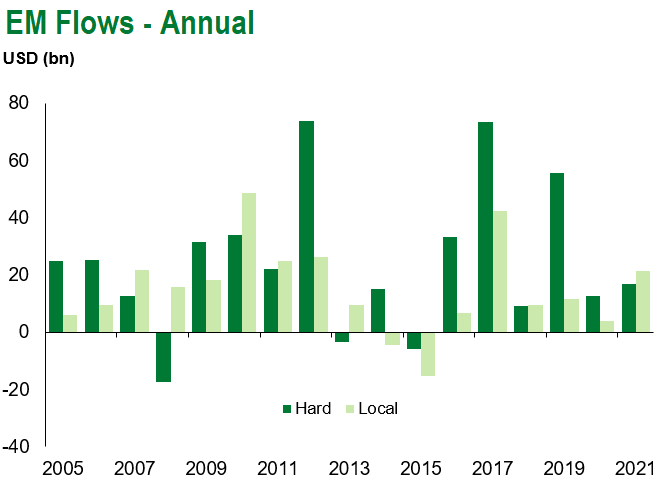
Source for graphs: Bloomberg, JPMorgan, Gramercy. As of July 30, 2021.
COVID Resources
Emerging Markets COVID-19 Case Summary
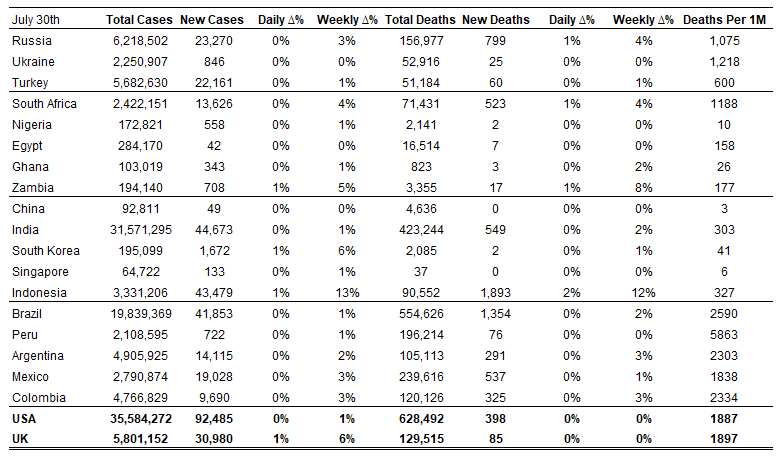
Source: Worldometer as of July 30, 2021.
Additional Crisis Resources:
Johns Hopkins COVID-19 Case Tracker
For questions, please contact:
Kathryn Exum, Senior Vice President, Sovereign Research Analyst, [email protected]
Petar Atanasov, Senior Vice President, Sovereign Research Analyst, [email protected]
Tolu Alamutu, CFA, Senior Vice President, Corporate Research Analyst, [email protected]
James Barry, Vice President, Corporate Research Analyst, [email protected]
This document is for informational purposes only. The information presented is not intended to be relied upon as a forecast, research or investment advice, and is not a recommendation, offer or solicitation to buy or sell any securities or to adopt any investment strategy. Gramercy may have current investment positions in the securities or sovereigns mentioned above. The information and opinions contained in this paper are as of the date of initial publication, derived from proprietary and nonproprietary sources deemed by Gramercy to be reliable, are not necessarily all-inclusive and are not guaranteed as to accuracy. This paper may contain “forward-looking” information that is not purely historical in nature. Such information may include, among other things, projections and forecasts. There is no guarantee that any forecasts made will come to pass. Reliance upon information in this paper is at the sole discretion of the reader. You should not rely on this presentation as the basis upon which to make an investment decision. Investment involves risk. There can be no assurance that investment objectives will be achieved. Investors must be prepared to bear the risk of a total loss of their investment. These risks are often heightened for investments in emerging/developing markets or smaller capital markets. International investing involves risks, including risks related to foreign currency, limited liquidity, less government regulation, and the possibility of substantial volatility due to adverse political, economic or other developments. The information provided herein is neither tax nor legal advice. Investors should speak to their tax professional for specific information regarding their tax situation.